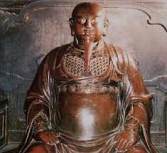What is the history of Wudang Taoism? From the Zhou Dynasty to the Eastern Han Dynasty many Taoist Internal Alchemists and hermits longed for a secluded place deep in Mount Wudang for their practice of meditation and esoteric arts:Yee Xee, the famous disciple of Lao Tzu, once practiced internal alchemy in First Heavenly Gate on Mount Wudang.
Taoism practice grew strong on Wudang in the Tang and Song Dynasty; famous Taoist figures such as Yao Jian, Sun Si Miao, Lu Dong Bing, Guo Tian Wei, and Chen Tuan began their practice of Internal Alchemy in retreat on this sacred mountain.
Ma Ming Sheng, Yin Chang Sheng, who are widely-known alchemy practitioners in the Eastern Han Dynasty, once sought to retreat here in Wudang to practice alchemy in company with the beautiful scenery. Dai Meng, a famous army general in the Han Dymasty, left his military office and studied internal alchemy with his teacher on Wudang. Ever since the foundation of Taoism in China, Mt. Wudang has gradually became the most ideal location for Taoists activities and retreat practice in central China. In the Wei-Jin South and North Dynasty, the Tao- practitioners who moved into Mt. Wudang increased in numbers. In the Tang and Song Dynasty,
|
 | Wudang Taoism evolved into its peak development time, during which famous Taoist figures began to establish their hermitage house here for their undertakings of the practice of Taoist Internal Alchemy one after another. The Ming Dynasty announced the peak period for development of Wudang Taoism, and Zhen Wu was respected as a God at the royal palace, and Zhang Sanfeng, the famous Taoist and founder of Taiji on Mt. Wudang, was called upon to show up in the royal court. |